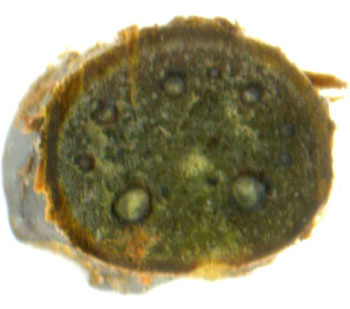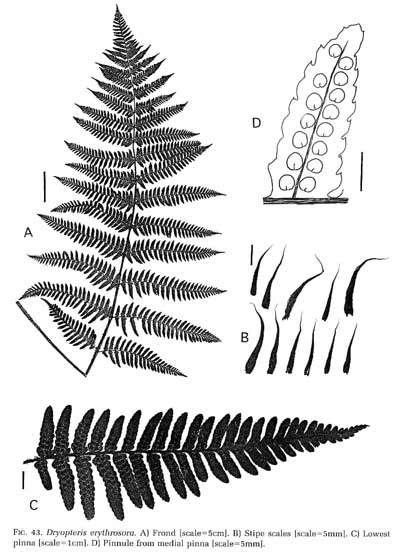| Dryopteris erythrosora | ||
Autumn fern | ||
|
Etymology
From the Greek erythros meaning red; usually used as a prefix to indicate the color, thus it means having red sori.
Description
Rhizome: short-creeping, subterranean.
Frond: 60 cm high by 25 cm wide, evergreen, monomorphic, blade/stipe ratio: 3:2 to 2:1. Stipe: grooved, straw-colored, tinted red when young, scales linear to linear-lanceolate, entire at margin, brown to blackish brown, larger ones at base 1 cm, vascular bundles: two primary bundles and several smaller ones in a c-shaped pattern. Blade: 2-pinnate, triangular, acuminate at apex, somewhat leathery, bullate scales on lower surface of costa. Pinnae: 10 to 15 pair, lowest pair anadromic, catadromic above; pinnules lower pinnules often longer, those nearer the base and the rachis stalked and eared; costae grooved above, continuous from rachis to costae; margins crenate; veins free, forked. Sori: round, in 1 row between midrib and margin, on the entire frond, indusium: reniform, red, attached at a sinus, sporangia: brownish, maturity: summer to fall. Culture
Habitat: forest floor in lowlands.
Distribution: Honshu, Shikoku and Kyushu, Phillipines, China, Korea.
Hardy to -25�C, USDA Zone 5.
Distinctive Characteristics
red indusia, red new growth
Synonyms
Aspidium erythrosorum D. C. Eaton Dryopteris cystolepidota (Miq.) C. Chr. Lastrea erythrosora Moore Nephrodium erythrosorum Hook. |
|
|

Dryopteris erythrosora. Two primary bundles at the stipe face, three secondary bundles, and a few smaller ones, all in a c-shape. �Scan: Tom Stuart |

Dryopteris erythrosora. The species is noted for its bronzy color on emergence; this fades to green over a few weeks. �Photo by Tom |
